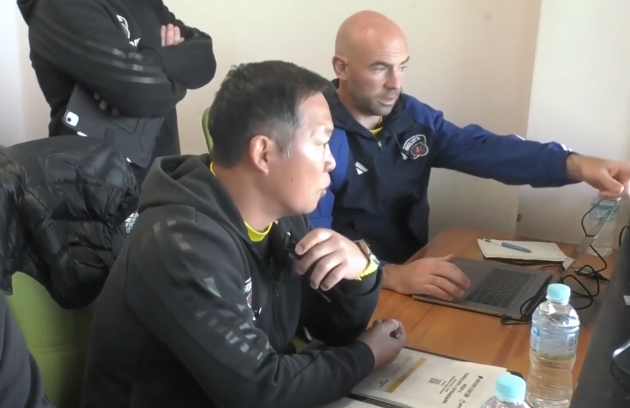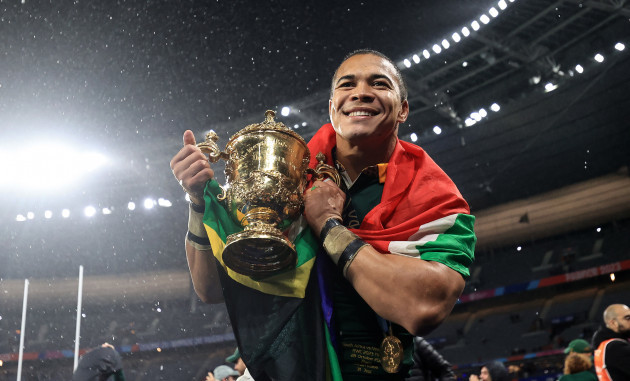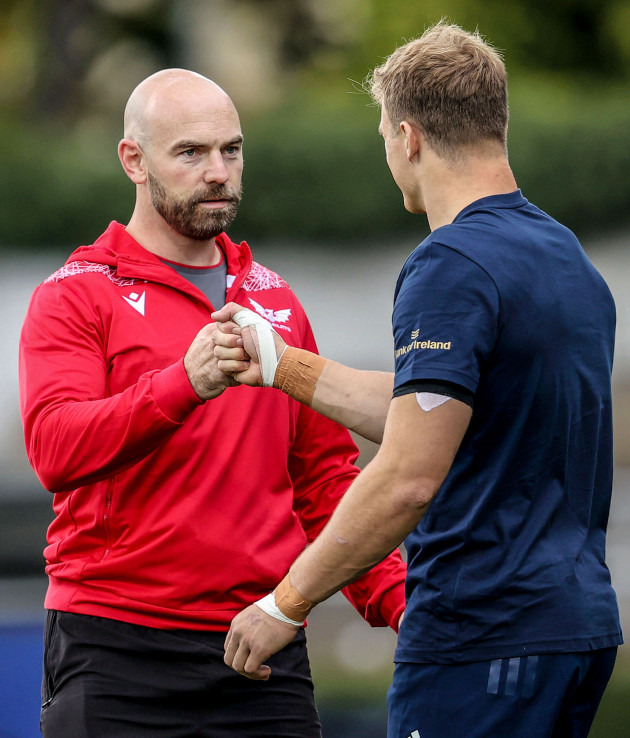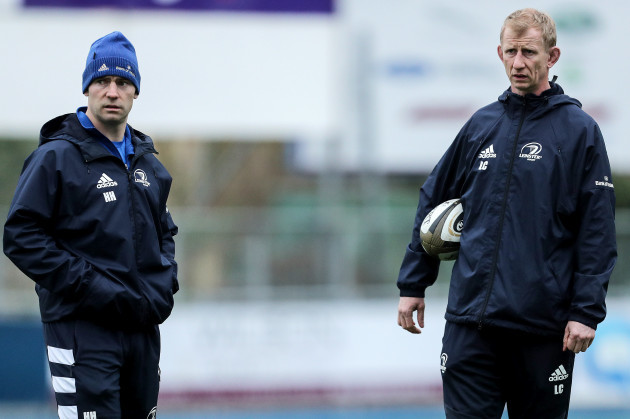WHEN HUGH HOGAN explains that he earned a black belt in Shotokan karate when he was still only 15, it all begins to make more sense.
First, the fact that Hogan plies his trade as a defence coach in rugby, having specialised in contact skills when he was part of the staff with his native Leinster. It’s not difficult to see the overlap between his sporting passions.
Then there’s the fact that Hogan is now coaching in Japan, where he is the defence and breakdown coach for Tokyo Suntory Sungoliath, one of the biggest clubs in the country.
His background in karate meant the Dublin man always had an affinity with Japan. Studying martial arts gave Hogan an early introduction to Japanese culture and discipline, as well as a few bits of the language.
He started when he was 12, following a primary school friend down to the Ballyroan Karate club. Soon after, Hogan’s mother, Leslie, started too. She had been mugged close to their home, her handbag stolen, and wanted to do something about the sudden feeling of vulnerability.
Leslie has since become a 5th dan black belt. “She’s a determined lady,” says her son. The apple didn’t fall far from the tree.
Hugh’s sister, Niamh, is a 4th dan black belt so it really is a family affair. Sadly, their karate sensei, Brendan Perry, passed away suddenly at the age of 60 last month, having been a big influence on Hugh in his formative years.
Hogan was a 1st dan black belt but had to stop karate when he turned 20, rugby with Trinity demanding more time. He chose well. After becoming an AIL legend by captaining St Mary’s to their 2012 title, he has made his career in rugby coaching.
Hogan spent nine years working with Leinster, initially as an academy coach before being promoted to contact skills coach with Leo Cullen’s senior side in 2017. He earned consistently glowing reviews from the province’s players but in 2021, decided to leave for a new challenge as defence coach with Scarlets.
Hogan was gone a year later after a tough season for the Welsh region and it was hard not to see him as having been a scapegoat as the most recent man in the door. You wondered where rugby would take him next. Lo and behold, he is thriving in his new role in Tokyo.
After impressing with his analysis of the team’s defence and breakdown during his interview with Sungoliath, Hogan was offered the gig and signed a one-plus-one-year contract that means he has to option to extend into next season.
Hogan is the only non-Japanese coach in Sungoliath’s set-up, which is unusual given the influx of foreign coaches into the League One competition. It has been a bit strange to see the Irishman in the coaching box amongst his Japanese colleagues.
“Ah, there’s the pasty guy!” jokes Hogan, who moved to Tokyo in mid-August last year and was joined by his partner and son in October. They live in the Fuchū area, one of the many cities that make up the gigantic Tokyo. It’s a vibrant neck of the woods and their place is only a five-minute cycle from Sungoliath’s clubhouse.
Life is far from what they knew in Dublin and then the lovely village of Mumbles near Swansea when Hogan was with Scarlets.
“I came to Japan with a mindset whereby I wanted to make sure I was very open to learning and taking things in,” says Hogan, who enjoys the Japanese food.
“I said that everything I know is wrong and I’m going to assume that the way they do something is right.
“I wanted to try and dispel any biases I might have. I’m glad I did that because it has given me a way to digest a lot of things, rather than just seeing it as different.”
Like every other club, Suntory have a crop of non-Japanese players, including superstars Cheslin Kolbe and Sam Cane. But the bulk of players are native and while Hogan’s Japanese is coming along nicely, especially the rugby lingo, he leans on the two full-time interpreters who are at every meeting and training session.
This magnifies the need for Hogan to be as precise as possible so nothing is lost in translation.
“I have to be very clear and succinct. It’s not just the message, it’s making sure the wording is right, that it’s in a pure, simple form, linking back to imagery, making it digestible.
“Coaches always say that but when people don’t fully understand the words coming out of your mouth, it’s that challenge to make sure it resonates and they understand.”
Rugby in Japan is different to what we know in this part of the world. While it’s hugely popular in schools and universities, it only really continues thereafter because of massive companies like Suntory, a billion-dollar brewing and distilling company.
Other big Japanese companies like Panasonic, Toshiba, Toyota, Honda, and Mitsubishi own and run clubs in League One. For the university players who don’t join one of those companies or earn a professional contract, their involvement in rugby ends abruptly.
“You’re either recruited out of university to one of the professional teams and companies or you don’t play rugby anymore,” says Hogan.
“It’s kind of like American football – you either make the NFL or you never play again.”
This system also means that many of the players in League One are employees of the companies who run the clubs. Hogan estimates that a third of Sungoliath’s squad have jobs with Suntory, a third are full-time Japanese professional players, and the other third are foreign pro players.
The Suntory employees mostly work in the marketing department and their day jobs fit around the rugby team’s full-time schedule. Sungoliath run a programme that is basically identical to the big professional clubs in Europe in terms of its content, even if the make-up of their squad is different.
Historically, Japanese clubs trained for hours at a time on the pitch but that has changed over the last decade. Hogan has heard of some university teams still doing three-hour sessions involving huge amounts of contact, but the pro game’s approach is short and snappy.
While the pandemic was a big blow after the buzz Japanese rugby had built with the home 2019 World Cup, things are picking up again. Sungoliath had a crowd of 35,000 at their game against close rivals Toshiba this season and regularly draw in around 13,000.
League One is home to some of the biggest names in rugby. Hogan coaches Kolbe and Cane, while the likes of Pieter-Steph du Toit, Beauden Barrett, Damian de Allende, and Ardie Savea play in the competition.
“That’s another way the league has changed,” says Hogan. “Japan has always had high-quality foreign players but a few years ago it might be that guys went there for a few twilight years and retire.
“Now, you’ve guys coming more at the peak of their powers. Richie Mo’unga is 29 and signed for three years. At the same time, there are top-class international coaches. That combo has probably raised the level of the league.”
Steve Hansen, Robbie Deans, Dave Rennie, and Todd Blackadder are among the coaches guiding Japanese clubs, with a huge number of non-Japanese assistant coaches around the league too. Hogan is one of them but his boss is Kiyonori Tanaka, an employee of the Suntory company who played for Sungoliath. A lifer.
Sungoliath, who are five-time national champions, reached the semi-finals last year and are in the play-off spots again this season, with Hogan enjoying running the defence in a competition that has had to learn to love defending.
“Historically, the league has probably been what I’d think of as Super Rugby in the late 1990s – awesome rugby, 45-39 scorelines, everyone really excited apart from the two defence coaches who were crying because they’d leaked loads of points,” he says.
That is changing quickly, with the likes of Deans’ Panasonic Wild Knights and Frans Ludeke’s Kubota Spears leading the shift towards a more pragmatic approach.
Hogan is avid about learning so this new setting suits him. He worked with lots of world-class players in Leinster and seeing the likes of Cane and Kolbe up close now has underlined to him that there is no magic to their brilliance.
“When you see the best players in the world, it’s still hard work,” says Hogan.
He feels gratitude towards his home province, who brought him into the world of professional coaching.
Hogan picked up bits from all the coaches he worked alongside in Leinster. Joe Schmidt’s attention to detail, Jono Gibbes’ technical forwards coaching, Richie Murphy’s ability to boil vast knowledge down to concise chats with players, Cullen and Stuart Lancaster’s thoughtfulness about the game.
“I wouldn’t have had a coaching career were it not for Leinster,” says Hogan.
“I was in Leinster for nine years in the end, the first five with the academy. Even then, you’re still in the same room as the senior coaches and you’re preparing players to go on and play for Leinster. You’re very integrated.”
He doesn’t regret leaving for Scarlets, even though it didn’t work out as he had hoped.
Hogan knows it was the right time for him to make a move and stretch himself. He and his family loved the “stunning” Mumbles and he says the coaching experience was valuable.
“I learned a hell of a lot about myself and my biases, my strengths, my weaknesses. Because of that, you’re able to make changes and work on things.
“It was disappointing to do a season and finish up with them. It’s not what I would have wanted but going through a bit of pain and learning, now being able to apply that learning has been cathartic in the sense that I’m far more confident and capable now. I’m a far better coach now than I was when I went there.
“No journey is a straight road. There are ups and downs. The downs are the parts that give you the lessons. You’ve got to go into the trough to build the next wave.”





